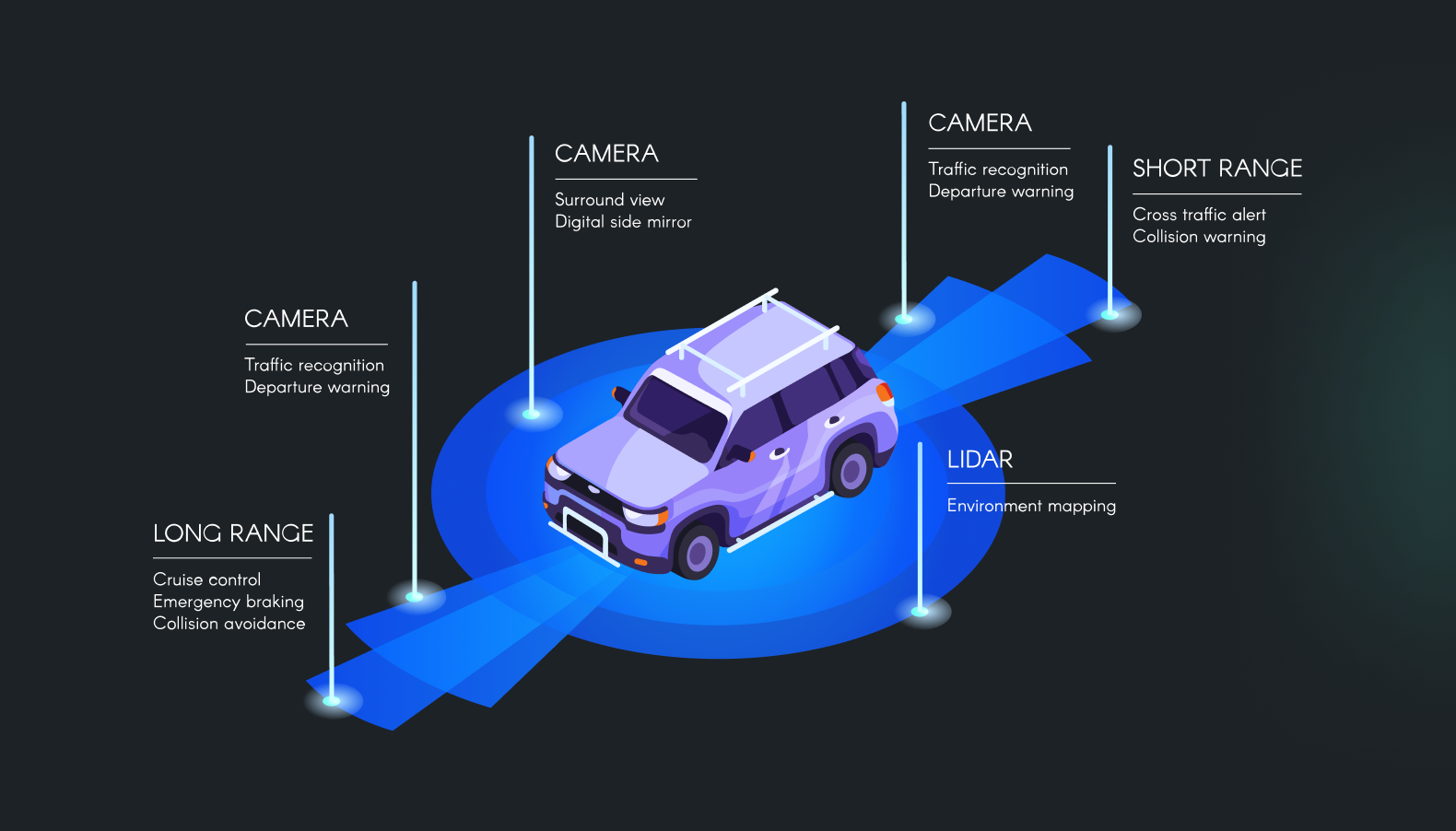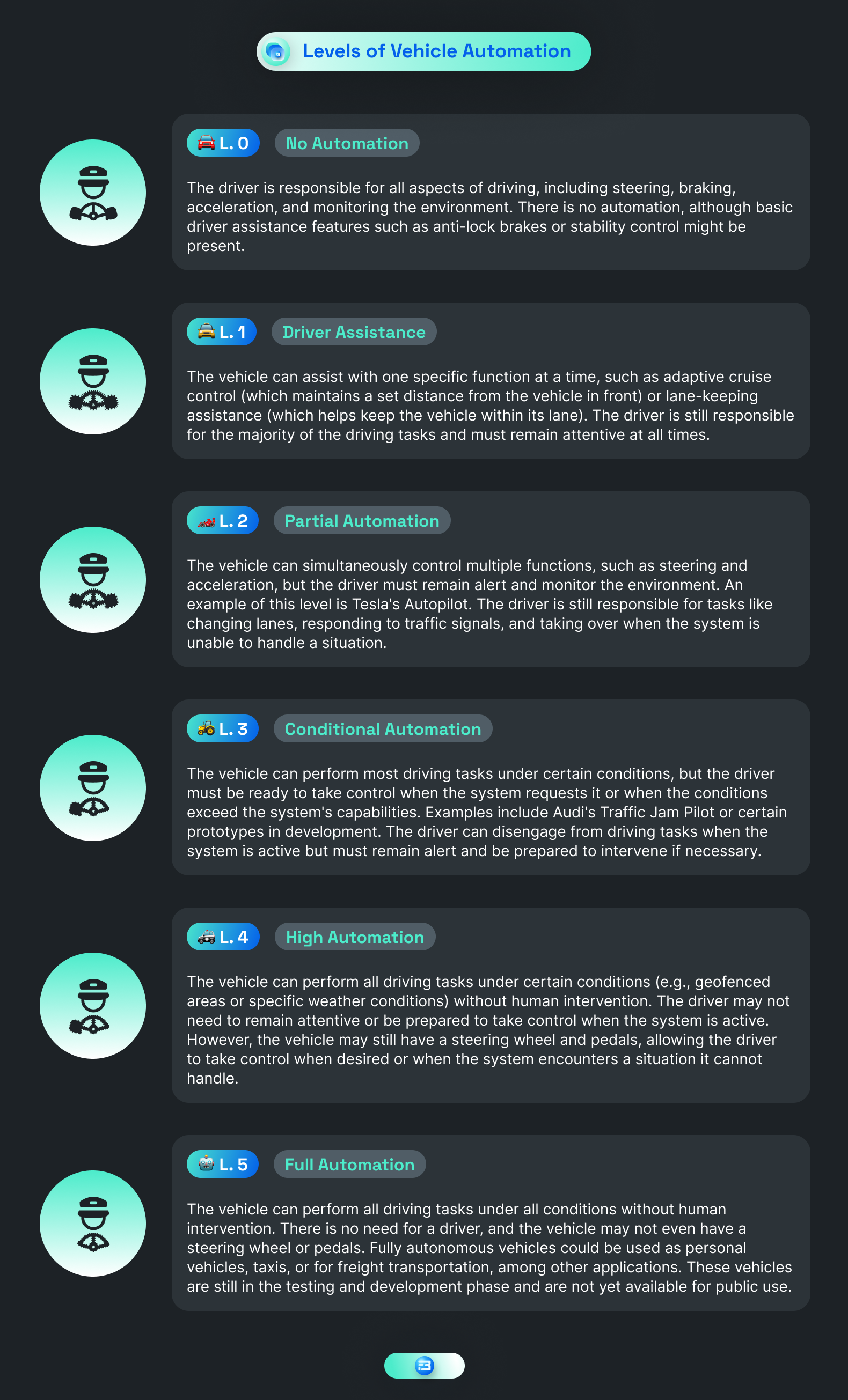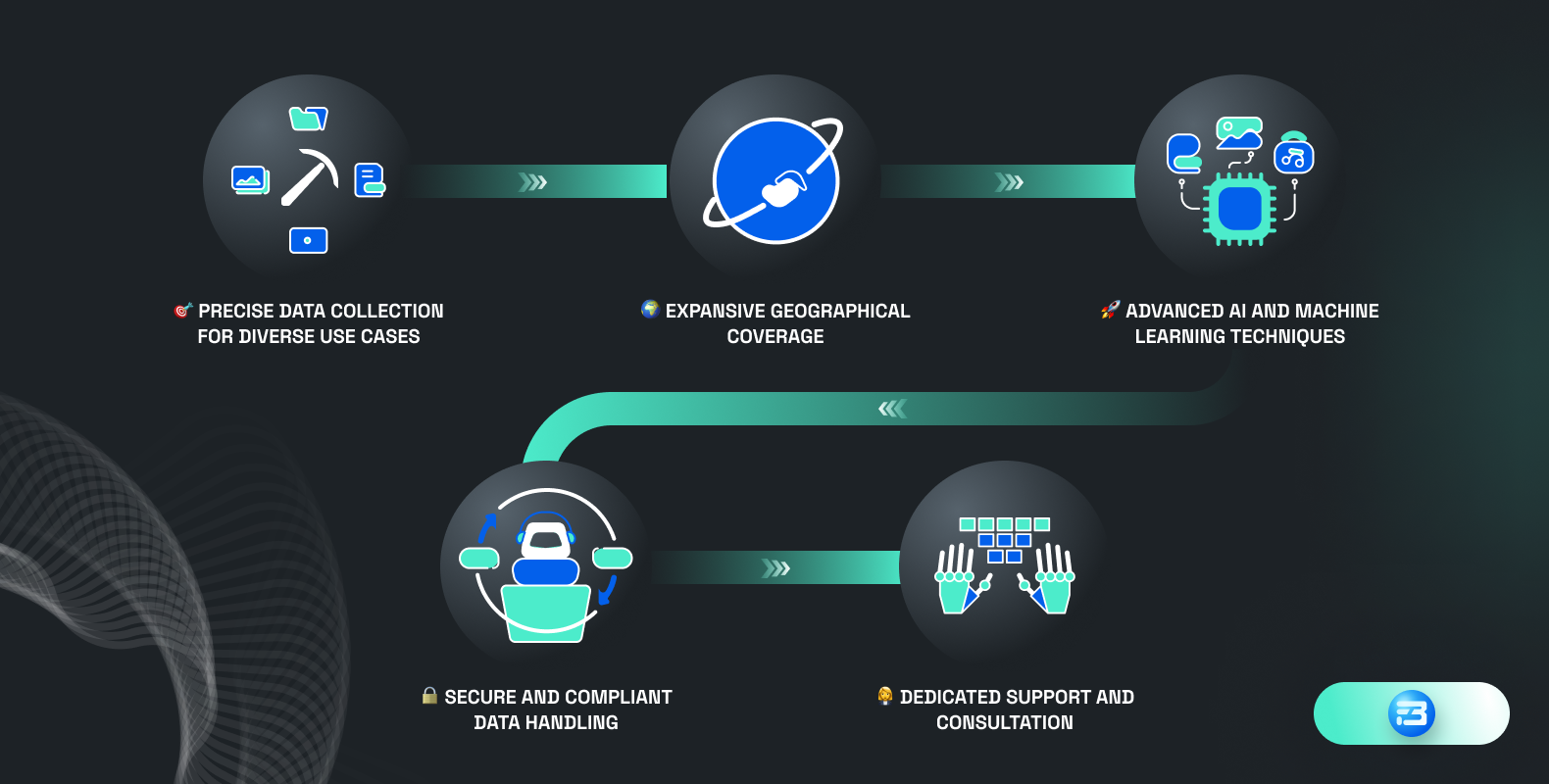Automotive AI
ADAS
What is ADAS? Explore Every Aspect of Driving Assistance
Drive with ease, as ADAS appease! Explore every aspect of automated driving assistance systems - history, types, applications, ADAS automation & more.
Automotive AI
ADAS
Drive with ease, as ADAS appease! Explore every aspect of automated driving assistance systems - history, types, applications, ADAS automation & more.

ADAS stands for Advanced Driver Assistance Systems. It is a collection of electronic systems and technologies designed to enhance vehicle safety, improve driving comfort, and support drivers in various driving situations. The primary purpose of ADAS is to reduce the likelihood of human error, which is a leading cause of road accidents, and to make driving safer and more efficient.
ADAS achieves this purpose by using a combination of sensors, cameras, and software to monitor the vehicle's surroundings and provide real-time feedback and assistance to the driver. This can include features such as adaptive cruise control, lane departure warning, automatic emergency braking, blind-spot monitoring, and parking assistance, among others.
By alerting the driver to potential hazards or taking corrective actions when necessary, ADAS helps prevent accidents, reduce the severity of those that do occur, and improve the overall driving experience. As a result, ADAS contributes to increased road safety, enhanced driving comfort, and reduced driver workload.
The evolution of Advanced Driver Assistance Systems (ADAS) has been a gradual process, with continuous advancements in technology, vehicle capabilities, and industry regulations. Here is an overview of how ADAS has evolved over time:
The main components of Advanced Driver Assistance Systems (ADAS) include sensors, cameras, a processing unit, and actuator systems. These components work together to gather data about the vehicle's surroundings, process the information, make decisions, and provide feedback or take corrective actions when necessary.
 Sensors and Cameras: ADAS relies on various sensors and cameras placed around the vehicle to gather data about its surroundings. These can include:
Sensors and Cameras: ADAS relies on various sensors and cameras placed around the vehicle to gather data about its surroundings. These can include:ADAS is a system that alerts the driver to potential dangers or takes action to prevent the possibility of an accident. ADAS-equipped vehicles detect the surroundings and then process this information fast and precisely through a computer system to provide the driver with the appropriate information.
The ADAS-equipped vehicles have a variety of high-tech sensors that augment your eyes and ears and the decision-making process of the driver's human brain.
Its ADAS system architecture comprises sensors, interfaces, and an efficient computer processor that combines all the information and makes decisions in real-time. The sensors continuously analyze the surrounding environment and transmit this information to the onboard ADAS computers to prioritize and act.
Advanced Driver Assistance Systems (ADAS) are becoming increasingly popular in modern vehicles, with estimates suggesting that by 2025, over 70% of all new cars sold worldwide will have some form of ADAS technology. These systems use advanced technologies such as radar, cameras, and other sensors to monitor the vehicle's surroundings and provide information or automatic action based on what it perceives.
Studies have shown that ADAS can significantly reduce the number of accidents and save lives. For instance, according to the National Highway Traffic Safety Administration (NHTSA), rearview cameras alone can reduce the number of backing crashes by 17%, while rear automatic braking can lower them by a massive 78%. Similarly, the Insurance Institute for Highway Safety (IIHS) found that forward collision warning systems lower front-to-rear crashes by 27%, and adding automatic braking nearly doubles the effectiveness of the system.
ADAS technology is also evolving rapidly, with new features being added all the time. For instance, some of the most advanced ADAS features currently available are Level 2+ active safety systems, which can manage steering and propulsion without the need for hands-on control from the driver under certain conditions, such as highway driving or stop-and-go traffic.
However, the effectiveness of ADAS features depends on the quality and quantity of the data used to train them. High-quality datasets play a critical role in the development and refinement of ADAS algorithms, allowing the system to make accurate and reliable decisions that can help prevent accidents and save lives.
Advanced Driver Assistance Systems (ADAS) provide a variety of features aimed at enhancing vehicle safety, improving driving comfort, and supporting drivers in different driving situations. These features work by using sensors, cameras, and data processing algorithms to monitor the vehicle's surroundings, analyze driving conditions, and provide assistance or intervention when necessary. Here is an overview of some common ADAS features, how they work, and their benefits to drivers:
1. Adaptive Cruise Control (ACC): ACC uses radar or lidar sensors to monitor the distance and relative speed of the vehicle ahead. It automatically adjusts the vehicle's speed to maintain a safe following distance, providing a more relaxed and comfortable driving experience, especially on long trips or in heavy traffic.
2. Lane Departure Warning (LDW) and Lane Keeping Assist (LKA):These features use cameras to monitor lane markings on the road. LDW alerts the driver if the vehicle unintentionally drifts out of its lane, while LKA actively steers the vehicle back into its lane. These systems help prevent accidents caused by driver fatigue or distraction and improve overall road safety.
3. Automatic Emergency Braking (AEB): AEB uses cameras, radar, or lidar sensors to detect potential collisions with vehicles, pedestrians, or other obstacles. If the system determines that a collision is imminent, it automatically applies the brakes to prevent or reduce the impact. This feature can help prevent accidents or mitigate their severity.
4. Blind Spot Monitoring (BSM): BSM uses radar or ultrasonic sensors to detect vehicles in the driver's blind spots. When another vehicle is detected, the system provides visual or auditory alerts to warn the driver. This feature helps drivers make safer lane changes and prevents accidents caused by vehicles hidden in blind spots.
5. Traffic Sign Recognition (TSR): TSR uses cameras to identify traffic signs such as speed limits, stop signs, and yield signs. The detected signs are then displayed on the vehicle's instrument panel or head-up display, keeping the driver informed about important road regulations and reducing the likelihood of traffic violations.
6. Parking Assistance (PA): PA systems use cameras and ultrasonic sensors to help drivers park their vehicles more easily and safely. The system provides visual guidance, and auditory alerts, or even takes over the steering control to help the driver maneuver into a parking space. This feature reduces the risk of parking-related accidents and eases driver stress in tight or crowded parking areas.
7. High Beam Assist (HBA): HBA uses cameras to detect oncoming vehicles and automatically switches between high and low beams to optimize visibility without blinding other drivers. This feature improves nighttime driving safety and reduces the need for manual high-beam adjustments.
8.Driver Monitoring Systems: A driver Monitoring System (DMS) is an advanced safety technology designed to detect and respond to driver inattention, fatigue, or distraction. By using cameras, sensors, and sophisticated algorithms, DMS helps maintain a high level of safety on the road and assists drivers in staying focused and alert.
⚡ Awesome Read - What is Driver Drowsiness Detection System & How does training data aid DDS algorithms?
Certainly! Many car manufacturers offer Advanced Driver Assistance Systems (ADAS) features in their vehicles, with some variation in the specific features and their implementation. Here are a few examples of ADAS features in different car models:
The data collected by Advanced Driver Assistance Systems (ADAS) sensors is processed and interpreted using a combination of hardware and software components. The key steps involved in processing and interpreting the data are as follows:
Algorithms and machine learning play a crucial role in ADAS decision-making by enabling the system to process sensor data, recognize patterns, and make informed decisions based on the vehicle's environment and driving conditions. These techniques help ADAS systems analyze complex and dynamic situations in real time and provide appropriate assistance or interventions to enhance vehicle safety and driving comfort.
Algorithms: Algorithms are a set of rules, procedures, or formulas that are used to process data, solve problems, or perform specific tasks. In ADAS, algorithms are employed for various purposes, such as preprocessing sensor data, detecting specific features (e.g., lane markings, traffic signs), and making decisions based on predefined rules or thresholds.
For example, an algorithm may be used to calculate the distance between the vehicle and a detected obstacle and determine whether a collision warning or automatic emergency braking should be activated.
Machine Learning: In ADAS, machine learning models can be used for tasks such as object recognition, environment classification, and behavior prediction. These models are trained on large datasets, allowing them to learn complex patterns and relationships between different variables.
Once trained, these models can be used to process real-time sensor data and make decisions based on the patterns they have learned.
Machine learning can be particularly beneficial for ADAS decision-making because:
Some examples of machine learning applications in ADAS include:
Algorithms and machine learning play a vital role in ADAS decision-making by enabling the system to process complex sensor data, recognize patterns, and make informed decisions in real time.
The staggering increase in the ADAS market is due to the increasing demand for more comfortable and safer driving systems. In addition, the enormous advantages associated with ADAS regarding reducing the risk of losing property and life and increasing the stringency of rules drive the development of more advanced driver-aid systems.
Collecting enormous training data is the first step toward developing ADAS algorithms. The most crucial aspect of ADAS systems is the data-intensive tasks like deep learning for training and inference.
The training aids the deep neural networks in performing automotive AI tasks, such as object identification and voice and image recognition. In addition, inference training aids the system in identifying the data results.
For example, when the algorithm tries to recognize objects, it must be trained extensively with hundreds of pictures. When the image is loaded into the deep neural network, it can be prepared to admit it.
Many labeled and unlabeled training datasets are required to develop self-driving systems that can accurately handle complex driving situations. Synthetic data from several sensors simulating outdoor conditions (vehicles, pedestrians, cars, objects, objects, weather) are also used to train models.
To collect this data, you must use the data other innovators provide or implement it yourself and then scale the process. Larger automakers employ fleets of test vehicles to gather information. Unfortunately, capturing all this data on your own with the limited number of test vehicles isn't enough. Test vehicles usually operate only in areas, including a little city group. For self-driving cars to be more widespread, their AI systems must be trained with global datasets.
Self-driving vehicles start and end with data recorded from the moment sensors in a car detect an image, sound, or even a tactile experience as a complicated procedure of recognition, action decision-making, and the reaction takes place.
It is also crucial for vehicles to collect this information and capture sights, sounds, or sensations on the road, not enough. All this data needs to be acknowledged as valid, verified, and validated in a way that is efficient enough and sophisticated enough to ensure that all security and technical requirements are fulfilled.
Ensuring accuracy and reliability in the decision-making processes of Advanced Driver Assistance Systems (ADAS) is critical for their overall performance and safety. Several strategies and techniques are employed to achieve this:
Regulations and standards governing Advanced Driver Assistance Systems (ADAS) technology vary by country and region. They generally focus on ensuring the safety, reliability, and performance of these systems. Here are some key organizations and regulatory frameworks that have a significant impact on ADAS technology:
The levels of vehicle automation are defined by the Society of Automotive Engineers (SAE) International in their J3016 standard. There are six levels, ranging from Level 0 (no automation) to Level 5 (full automation). Here's a brief overview of each level:
 Level 0 (No Automation): The human driver is responsible for all driving tasks, including steering, braking, and acceleration. There is no vehicle control by automated systems, but there may be some driver assistance features, such as warning systems.
Level 0 (No Automation): The human driver is responsible for all driving tasks, including steering, braking, and acceleration. There is no vehicle control by automated systems, but there may be some driver assistance features, such as warning systems.Advanced Driver Assistance Systems (ADAS) typically include features that fall within Level 1 or Level 2 automation. These systems can assist the driver in various tasks, such as maintaining a safe distance from other vehicles, staying within the lane, and parking. While ADAS can significantly enhance safety and driver comfort, it's essential to remember that the driver must remain alert and engaged in the driving process at all times.
How does the adoption of ADAS affect driving behavior and the role of the driver?
The adoption of Advanced Driver Assistance Systems (ADAS) has both positive and negative effects on driving behavior and the role of the driver. Here are some of the ways ADAS impacts drivers:
Positive Effects
1.Enhanced Safety: ADAS technologies, such as automatic emergency braking, lane departure warnings, and adaptive cruise control, can help reduce the likelihood and severity of accidents by assisting drivers in maintaining a safe driving environment.
2. Reduced Driver Fatigue and Stress: ADAS can alleviate some of the mental and physical workload associated with driving, especially during long trips or in heavy traffic. Features like adaptive cruise control and lane-keeping assist can help drivers maintain a comfortable and safe journey.
3. Increased Awareness: Some ADAS features, like blind-spot monitoring and rear cross-traffic alerts, can enhance drivers' situational awareness by providing additional information about their surroundings that may not be easily perceivable otherwise.
Negative Effects
In conclusion, Advanced Driver Assistance Systems (ADAS) is a suite of technologies designed to enhance vehicle safety, assist drivers in various driving tasks, and pave the way toward fully autonomous driving. ADAS encompasses a wide range of features, including adaptive cruise control, lane-keeping assist, automatic emergency braking, blind-spot monitoring, and many others.
While ADAS has demonstrated its potential to improve road safety and reduce driver workload, it also presents several challenges and limitations in achieving full autonomy, such as sensor limitations, software development, high-definition mapping, V2X communication, cybersecurity, regulatory hurdles, public acceptance, and ethical considerations.
The adoption of ADAS has both positive and negative effects on driving behavior and the role of the driver. While these systems can enhance safety and situational awareness, they also pose risks related to overreliance, skill degradation, misunderstanding system limitations, and driver distraction.
Ultimately, the successful integration of ADAS and its evolution towards full autonomy relies on addressing these challenges, ensuring proper education and training for drivers, developing robust and secure systems, and fostering public trust in these technologies. As advancements continue to be made, ADAS has the potential to revolutionize the way we drive and contribute to a safer, more efficient, and more sustainable transportation future.

FutureBeeAI is revolutionizing data collection for Advanced Driver Assistance Systems.
Are you an ADAS developer searching for the most accurate and relevant data to fine-tune your intelligent driving solutions?
We are here to provide you with cutting-edge, customized data collection tailored specifically to your unique ADAS requirements.
 🎯 Precise Data Collection for Diverse Use Cases
🎯 Precise Data Collection for Diverse Use Cases
At FutureBeeAI, we understand that the key to developing robust ADAS lies in the quality of the data you work with. That's why we offer comprehensive data collection services for a wide range of use cases, including lane detection, object recognition, pedestrian tracking, collision avoidance, and more.
🌍 Expansive Geographical Coverage
Our data collection capabilities span across various geographical locations, ensuring that your ADAS is tested and optimized for diverse road conditions, environments, and driving scenarios.
🚀 Advanced AI and Machine Learning Techniques
FutureBeeAI leverages state-of-the-art AI and machine learning technologies to accurately annotate and categorize data, delivering a rich dataset that empowers your ADAS to learn and adapt quickly.
🔒 Secure and Compliant Data Handling
Your data's security and privacy are our top priority. FutureBeeAI adheres to stringent data protection and compliance standards, ensuring that your information is always handled with the utmost care.
👩💼 Dedicated Support and Consultation
Our team of ADAS experts is always available to support you throughout the data collection process. From understanding your project requirements to providing insights and recommendations, we're here to help you achieve your ADAS development goals.
Choose FutureBeeAI for Unparalleled Data Collection Services
At FutureBeeAI, we're passionate about driving the future of ADAS development. Partner with us and unlock the full potential of your intelligent driving solutions.
Get in touch with our team today to discuss your data collection needs and discover how FutureBeeAI can accelerate your ADAS development journey.
Acquiring high-quality AI datasets has never been easier!!!
Get in touch with our AI data expert now!
